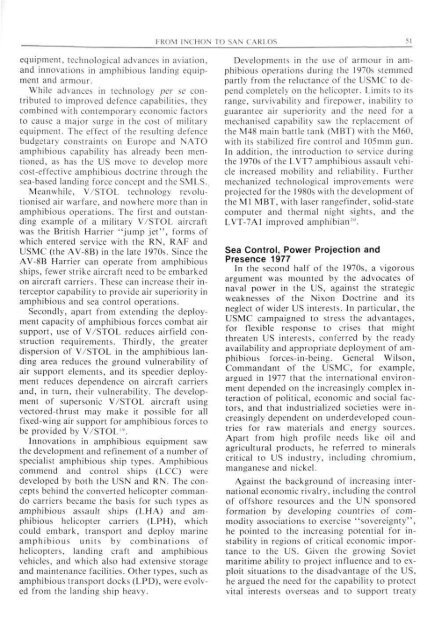ISSUE 76 : May/Jun - 1989 - Australian Defence Force Journal
ISSUE 76 : May/Jun - 1989 - Australian Defence Force Journal
ISSUE 76 : May/Jun - 1989 - Australian Defence Force Journal
- No tags were found...
You also want an ePaper? Increase the reach of your titles
YUMPU automatically turns print PDFs into web optimized ePapers that Google loves.
FROM INCHON TO SAN CARLOS 51equipment, technological advances in aviation,and innovations in amphibious landing equipmentand armour.While advances in technology per se contributedto improved defence capabilities, theycombined with contemporary economic factorsto cause a major surge in the cost of militaryequipment. The effect of the resulting defencebudgetary constraints on Europe and NATOamphibious capability has already been mentioned,as has the US move to develop morecost-effective amphibious doctrine through thesea-based landing force concept and the SMLS.Meanwhile, V/STOL technology revolutionisedair warfare, and nowhere more than inamphibious operations. The first and outstandingexample of a military V/STOL aircraftwas the British Harrier "jump jet", forms ofwhich entered service with the RN, RAF andUSMC (the AV-8B) in the late 1970s. Since theAV-8B Harrier can operate from amphibiousships, fewer strike aircraft need to be embarkedon aircraft carriers. These can increase their interceptorcapability to provide air superiority inamphibious and sea control operations.Secondly, apart from extending the deploymentcapacity of amphibious forces combat airsupport, use of V/STOL reduces airfield constructionrequirements. Thirdly, the greaterdispersion of V/STOL in the amphibious landingarea reduces the ground vulnerability ofair support elements, and its speedier deploymentreduces dependence on aircraft carriersand, in turn, their vulnerability. The developmentof supersonic V/STOL aircraft usingvectored-thrust may make it possible for allfixed-wing air support for amphibious forces tobe provided by V/STOL".Innovations in amphibious equipment sawthe development and refinement of a number ofspecialist amphibious ship types. Amphibiouscommend and control ships (LCC) weredeveloped by both the USN and RN. The conceptsbehind the converted helicopter commandocarriers became the basis for such types asamphibious assault ships (LHA) and amphibioushelicopter carriers (LPH), whichcould embark, transport and deploy marineamphibious units by combinations ofhelicopters, landing craft and amphibiousvehicles, and which also had extensive storageand maintenance facilities. Other types, such asamphibious transport docks (LPD), were evolvedfrom the landing ship heavy.Developments in the use of armour in amphibiousoperations during the 1970s stemmedpartly from the reluctance of the USMC to dependcompletely on the helicopter. Limits to itsrange, survivability and firepower, inability toguarantee air superiority and the need for amechanised capability saw the replacement ofthe M48 main battle tank (MBT) with the M60,with its stabilized fire control and 105mm gun.In addition, the introduction to service duringthe 1970s of the LVT7 amphibious assault vehicleincreased mobility and reliability. Furthermechanized technological improvements wereprojected for the 1980s with the development ofthe Ml MBT, with laser rangefinder, solid-statecomputer and thermal night sights, and theLVT-7A1 improved amphibian 2 ".Sea Control, Power Projection andPresence 1977In the second half of the 1970s, a vigorousargument was mounted by the advocates ofnaval power in the US, against the strategicweaknesses of the Nixon Doctrine and itsneglect of wider US interests. In particular, theUSMC campaigned to stress the advantages,for flexible response to crises that mightthreaten US interests, conferred by the readyavailability and appropriate deployment of amphibiousforces-in-being. General Wilson,Commandant of the USMC, for example,argued in 1977 that the international environmentdepended on the increasingly complex interactionof political, economic and social factors,and that industrialized societies were increasinglydependent on underdeveloped countriesfor raw materials and energy sources.Apart from high profile needs like oil andagricultural products, he referred to mineralscritical to US industry, including chromium,manganese and nickel.Against the background of increasing internationaleconomic rivalry, including the controlof offshore resources and the UN sponsoredformation by developing countries of commodityassociations to exercise "sovereignty",he pointed to the increasing potential for instabilityin regions of critical economic importanceto the US. Given the growing Sovietmaritime ability to project influence and to exploitsituations to the disadvantage of the US,he argued the need for the capability to protectvital interests overseas and to support treaty
















